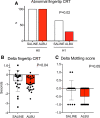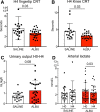Albumin versus saline infusion for sepsis-related peripheral tissue hypoperfusion: a proof-of-concept prospective study
- PMID: 38326920
- PMCID: PMC10848485
- DOI: 10.1186/s13054-024-04827-0
Albumin versus saline infusion for sepsis-related peripheral tissue hypoperfusion: a proof-of-concept prospective study
Abstract
Background: Albumin has potential endothelial protective effects through antioxidant and anti-inflammatory properties. However, the effect of albumin on peripheral tissue perfusion in human sepsis remains poorly known.
Methods: Bi-centric prospective study included patients with sepsis with or without shock and prolonged CRT > 3 s despite initial resuscitation. Clinicians in charge of the patients were free to infuse either saline 500 mL or human serum albumin 20% 100 mL over 15 min. Global hemodynamic parameters as well as peripheral tissue perfusion were analyzed after 1 (H1) and 4 h (H4). The primary endpoint was CRT normalization (< 3 s) at H1.
Results: 62 patients were screened, and 50 patients (13 sepsis and 37 septic shock) were included, 21 in the saline group and 29 in the albumin group. SOFA score was 8 [5-11], and SAPS II was 53 [45-70]. Median age was 68 [60-76] years with a higher proportion of men (74%). The primary sources of infection were respiratory (54%) and abdominal (24%). At baseline, comorbidities, clinical and biological characteristics were similar between groups. At H1, CRT normalization (< 3 s) was more frequent in patients receiving albumin as compared to patients treated by saline (63 vs 29%, P = 0.02). The decrease in fingertip CRT was more important in the albumin group when compared to saline group (- 1.0 [- 0.3; - 1.5] vs - 0.2 [- 0.1; - 1.1] seconds, P = 0.04) as well as decrease in mottling score. At H4, beneficial effects of albumin on peripheral tissue perfusion were maintained and urinary output trended to be higher in the albumin group (1.1 [0.5-1.8] vs 0.7 [0.5-0.9] ml/kg/h, P = 0.08). Finally, arterial lactate level did not significantly change between H0 and H4 in the saline group but significantly decreased in the albumin group (P = 0.03).
Conclusion: In patients with resuscitated sepsis, albumin infusion might lead to greater improvement of tissue hypoperfusion compared to saline.
Clinicaltrials: gov Identifier: NCT05094856.
Keywords: Albumin; Capillary refill time; Mottling; Sepsis; Tissue perfusion.
© 2024. The Author(s).
Conflict of interest statement
H. Ait-Oufella won the Albumin Awards Program (Albus) in 2020. B. Guidet obtained a research grant and personal fees (speaker and consultant) from Grifols.
Figures


Comment in
-
Albumin for sepsis-related peripheral tissue hypoperfusion.Crit Care. 2024 Mar 14;28(1):79. doi: 10.1186/s13054-024-04846-x. Crit Care. 2024. PMID: 38486295 Free PMC article. No abstract available.
References
-
- Rudd KE, Johnson SC, Agesa KM, Shackelford KA, Tsoi D, Kievlan DR, Colombara DV, Ikuta KS, Kissoon N, Finfer S, et al. Global, regional, and national sepsis incidence and mortality, 1990–2017: analysis for the Global Burden of Disease Study. Lancet. 2020;395(10219):200–211. doi: 10.1016/S0140-6736(19)32989-7. - DOI - PMC - PubMed
MeSH terms
Substances
Associated data
LinkOut - more resources
Full Text Sources
Medical
Research Materials

